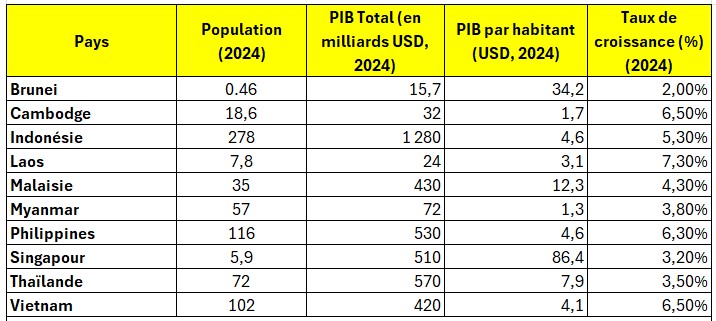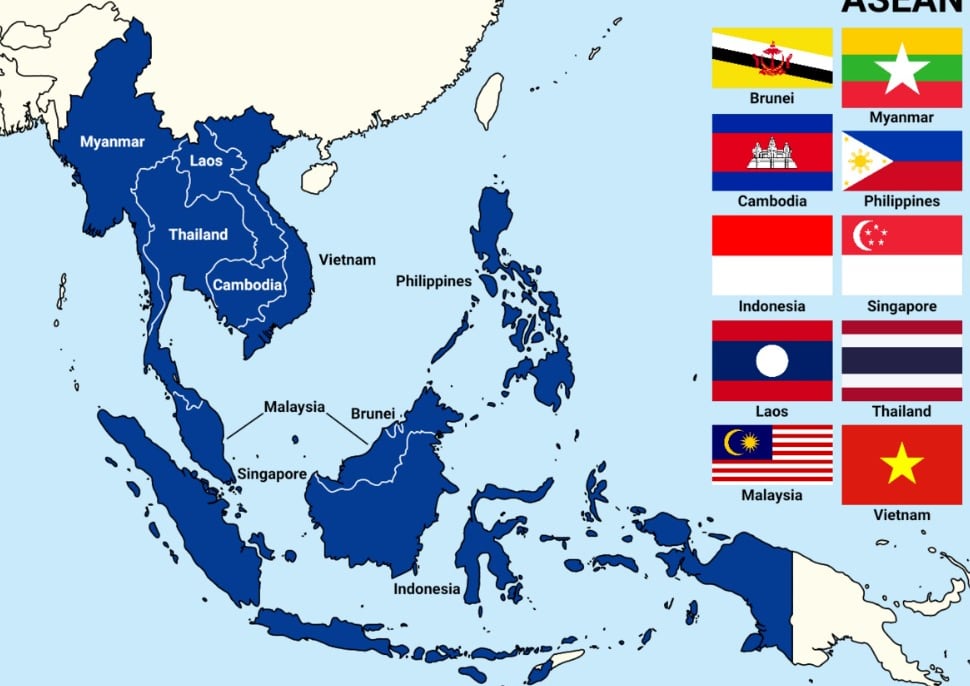

ASEAN: Population and economic data:
Population Growth
The ASEAN population continues to grow moderately, with countries such as the Philippines, Vietnam, and Indonesia seeing population increases. This remains a key factor driving domestic demand and regional economic activity.
Total GDP and GDP per Capita
The total GDP of ASEAN in 2024 is estimated at approximately $3.44 trillion USD. However, there is significant variation in GDP per capita across the region. Countries like Singapore remain well above the regional average, while nations such as Cambodia and Myanmar continue to have lower GDP per capita. Projections also indicate gradual increases in GDP per capita in developing countries.
Economic Growth
Economic growth forecasts for 2024 suggest that the region will continue to expand at a steady pace. Smaller economies like Cambodia, Laos, and Vietnam are expected to maintain high growth rates (above 6%), a positive indicator for their development. Larger economies such as Indonesia, the Philippines, and Thailand are also projected to achieve solid growth, though less spectacular than that of the smaller economies.
In 2025, Southeast Asia has established itself as one of the most dynamic regions in the world. With 650 million inhabitants, a combined GDP of over $3.3 trillion, and an average annual growth of 4–5%, ASEAN—a bloc of ten countries from Indonesia to Vietnam, including Singapore and Thailand—is increasingly attracting Western SMEs seeking new markets.
Yet behind these promising figures lie significant challenges: complex regulations, fierce competition, uneven infrastructure, and geopolitical risks.
So how can these opportunities be transformed into tangible success? What strategies ensure sustainable market entry, and which pitfalls must be avoided? Through inspiring successes and instructive failures, we explore how SMEs can thrive in Southeast Asia.
ASEAN: A Booming Market
ASEAN is no longer just an emerging region—it is a major economic player, driven by a growing middle class (over 350 million consumers), sectoral diversification (manufacturing, services, agri-food, renewable energy), and strategic trade agreements like the RCEP, facilitating exchanges between 15 countries including China and Japan.
For Western SMEs, the advantages are numerous:
Young, skilled, and competitive workforce: with salaries 3–5 times lower than in Europe or China.
Attractive tax incentives: e.g., 5–6 year tax exemptions in special economic zones.
Openness to foreign investment: up to 100% ownership in many sectors.
Ideal geostrategic location: at the crossroads of trade routes connecting China, India, and Australia.
However, these opportunities come with major challenges:
Complex regulations: varying by country, covering investment, customs, and labor laws.
Uneven infrastructure: while Singapore and Malaysia have modern networks, countries like Laos or Myanmar lag behind.
High competition: especially from well-established Chinese and local companies.
Geopolitical risks: trade tensions between the U.S. and China or political instability in some countries (e.g., Myanmar).
Inspiring Successes: When Adaptation Pays Off
French Agro-Food in Vietnam: A Winning Recipe
In 2023, a French SME specializing in premium dairy products successfully entered the Vietnamese market. Instead of exporting its products as-is, it adapted recipes to local tastes by reducing lactose and incorporating flavors like green tea and tropical fruits. It also obtained halal certification, essential for the Vietnamese and Indonesian markets.
Digital marketing on Facebook and TikTok helped reach consumers effectively. Result: 30% annual growth since 2022, with distribution in premium supermarkets in Hanoi and Ho Chi Minh City. The keys to success? Cultural adaptation and a strong partnership with a local distributor.
German BPO in the Philippines: Cutting Costs Without Sacrificing Quality
A German SME offering IT and customer support services opened a call center in Manila in 2023. By hiring 200 local employees and benefiting from five-year tax exemptions, it reduced costs by 40% compared to Germany, while maintaining high service quality.
The center has since expanded to serve the Australian market, demonstrating that economic zones and a skilled English-speaking workforce can be a springboard for Western businesses. Success relied on a carefully planned local strategy and integration of remote work tools to maintain continuity with Europe.
Spanish Renewable Energy in Thailand: The Winning Alliance
A Spanish solar panel manufacturer formed a joint venture with a Thai partner in 2023. Thanks to government subsidies for green energy and access to public tenders via the partner, the company signed contracts worth €10 million in 2024.
It is now preparing a pilot project in Vietnam, leveraging the reputation built in Thailand. This case highlights the importance of strategic local alliances to accelerate market access and benefit from public support.
Lessons from Failures: Pitfalls to Avoid
American Fast-Food in Cambodia: A Cultural and Logistical Failure
An American fast-food chain closed its Cambodian outlets after just two years (2022–2024). Reasons included fierce local competition (consumers preferred Asian brands like Jollibee), high logistical costs for fresh ingredients, and a menu poorly adapted to local tastes (lack of rice-based or spicy dishes).
Lesson: thorough market research and cultural adaptation are indispensable for success in Southeast Asia.
Japanese Automotive Supplier in Myanmar: Victim of Political Instability
A Japanese automotive parts manufacturer abandoned a Myanmar project in 2024 due to political instability after the 2021 coup, international sanctions, and frequent power shortages. This underscores the importance of evaluating geopolitical risks before entering a market in crisis.
Five Keys to Successful ASEAN Market Entry
Choose the right country: prioritize stable and open markets like Vietnam, Malaysia, Singapore, or Thailand.
Select reliable local consultant and partners: Distributors, agents, or joint ventures provide regulatory, network, and consumer insights.
Start with a light presence: Test the market with a representative office or employer-of-record setup; special economic zones offer initial tax incentives.
Adapt your offering: products, marketing, and distribution channels must match local tastes and platforms
Manage risks: diversify suppliers and monitor regulatory changes (customs, environmental standards).
2025–2026 Outlook: Opportunities and Risks
Promising Sectors
Technology & AI: smart cities, fintech, and e-commerce driven by a connected youth and growing middle class.
Health & Wellness: natural products, medical devices, and halal cosmetics see growing demand, particularly in Indonesia and Malaysia.
Renewable Energy: solar, wind, and hydro projects supported by government subsidies, notably in Thailand and Vietnam.
Risks to Monitor
U.S. protectionism: tariffs and trade tensions could impact ASEAN exports.
Chinese slowdown: slower growth in China directly affects ASEAN economies.
Geopolitical instability: South China Sea tensions or Myanmar’s political situation could disrupt markets.
Conclusion: ASEAN, A Market to Approach Wisely
ASEAN offers exceptional opportunities for Western SMEs—but careful preparation is key. Success comes from:
Adapting to local specifics
Partnering with reliable local players
Starting with a light presence before full commitment
Cultural adaptation, strategic partnerships, and a progressive approach are the keys to success. Failures remind us of the importance of market research and prudent country selection.
In 2025, ASEAN remains a promising yet demanding market. SMEs that navigate it wisely can reap rewards beyond expectations.
Are you ready to conquer ASEAN?
At thrivingAsia, we support SMEs in analyzing, planning, and succeeding in Southeast Asia. Contact us for a tailored strategy and turn your ambitions into tangible success!


